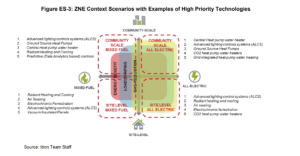Getting to zero energy and zero carbon buildings at scale begs the question: What are the technology priorities and gaps to achieving successful projects, and where is further investment needed? That is the subject of an extensive study analyzing technology gaps* led by Itron with New Buildings Institute, EPRI, Integral Group, Davis Energy Group, and UC Davis for the California Energy Commission (CEC) in 2017-2018. This project developed, in consultation with stakeholders and subject matter experts, a technical assessment of the current baseline and best-in-class ZE building technologies and strategies; and a gap analysis of key R&D needs for achieving the zero energy performance in a safe, equitable, and cost-beneficial manner. Nine factors were assessed for each identified technology to determine the relative priority compared to the rest of the technology list.
The research analysis offers direction for technology changes and new emphasis for utility programs, design teams and manufacturers including:
While technology does not pose the biggest challenge to achieving ZE, it is a significant solution. Even though stakeholders ranked technology as the fourth lowest out of 16 challenge areas, they also ranked it the second-most significant solution in the ‘silver bullet’ tool kit behind government policy and regulation.
Decades of energy efficiency as the first energy loading order in California has yielded a high level of development and market adoption. While efficient building technologies remain critical to make ZE ubiquitous, the focus now extends to control technologies, renewables, and grid management. Therefore, the greatest research gaps and market needs are technologies and strategies that support demand response and smart control.
The emergence of controls with embedded intelligence and predictive analytics enable buildings to schedule and balance load to minimize grid impact. Furthermore, renewable generation can align with demand to achieve grid harmonization with adoption of both electrical and thermal energy storage technologies.
The most prevalent research gap for technologies was identified as demonstrations and pilots, including market awareness and education, and was echoed by both experts that provided online input on technologies as well as those the team reached out to specifically.
To establish the relative research priority of various technologies, it is critical to evaluate them in their effectiveness at addressing not ZE by itself, but rather as the key drivers for ZE: energy, load shaping, and GHG reduction. This in turn requires examining the technologies’ potential scale (site versus community) and fuel (mixed versus all electric) implications.
Research gaps associated with ZE are often not limited to one technology or for that matter technology at all, the study found. As the primary objective of this work was to focus on technology specific research gaps with a focus on cost and performance targets, the following research gaps are barriers to ZE adoption at large and can be applicable across multiple technology and research areas:
System integration is a gap not specific to a technology or one end use, but an approach that considers the interplay between measures as a system. Controls and related algorithms are a good example of such a research gap. The systems approach is coordinating the specific technologies such lighting, HVAC, storage, pool pumps and water heating to operate in coordination and provide the maximum benefit to both energy and grid operations.
Demonstrations and pilots are another area transcending most specific technology types. Demonstrations typically allow for actual field placement of technology out of the laboratory realm to prove performance and longevity in real world conditions. Such demonstrations and pilots serve to prove the reliability and bankability of technology and unearth hidden nuances of the interface of technology with other systems in the real world.
Alignment of policy and utility rates towards goals such as ZE is an important aspect to realize value proposition for technology implementation. This plays out especially where GHG reduction is a policy, but the utility rates may not be aligned to reflect the on-peak energy reduction which translates to GHG reduction. Such misalignment can often misinform the decision makers that apply technologies to solve problems for building owners.
ZE is fast coming of age in the design realm, where projects and buildings are designed to be ZE. However, the operational aspect is the frontier, which is even more important with its far-reaching impact on GHG reduction. However, making buildings more reliable, more controllable by grid operators and building operators, and able to cheaply provide the expected services to the occupants is not yet a possibility and needs more research.
Electric vehicles straddle a line between the transportation and building sectors. With increased adoption of EVs, further research is necessary to incorporate, manage and balance this new load at the individual site level and fleet scale.
Research, industry development and in-field use of building technologies is extensive and rapidly changing. Continual collaboration with leading design firms offers the greatest access to current trends affecting the path to ZE.
The outcomes of this study confirm that the market changes we are seeing related to growing applications for controls and grid-friendly buildings are on the right track, but that significantly faster deployment is needed. New climate policy models from Energy Innovation, featured in a recent New York Times article, show that seven key policies, including California-level stringency energy codes adopted nationally, would slash greenhouse gas emissions in the United States to roughly 50% by 2050, falling short of the 80% goals set in the Paris climate agreement (New York Times February 13, 2019). “There are no silver bullets,” the article says. “Pushing emissions to nearly zero would require a slew of actions to clean up nearly every corner of the American economy.” Time to get started.

